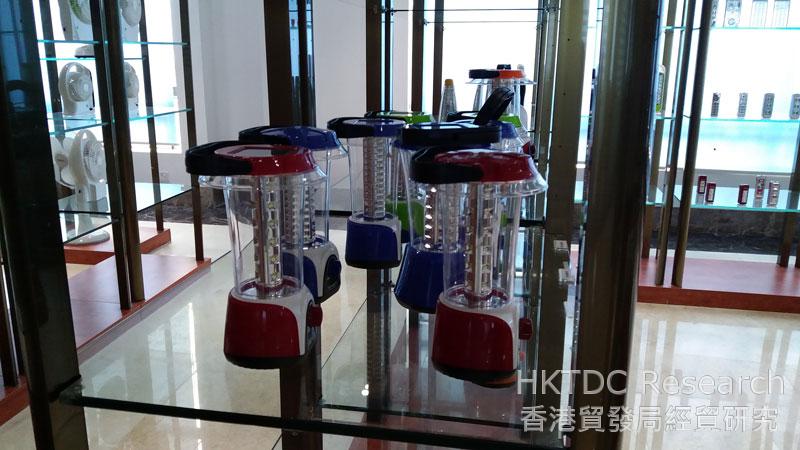Despite their differences, China and Vietnam both have much to gain under the ambitious Belt and Road Initiative.
Will prospects for the Hai Phong port be clearer thanks to BRI investment?
Although Vietnam has achieved remarkable economic progress in recent years, its poor infrastructure is still seen as likely to blight any future development. In particular, major network upgrades to its transport, power and technology systems are desperately needed if it is to deliver the smoother and more cost-effective trade flow that is vital for success in the region's increasingly connected markets.
In light of this, it could be argued that China's ambitious Belt and Road Initiative (BRI) could benefit Vietnam enormously. Under the terms of the BRI, China will help fund and construct a world-class network of high-speed railways, motorways, pipelines and ports across South Asia and Southeast Asia, with Vietnam seen as a key component of this blueprint for economic revitalisation.
Vietnam's strategic location and ease of access to its ASEAN neighbours has seen it earmarked for a pivotal role in the BRI. Indeed, its co-operation is required if China is to make good on its promise to deliver a series of trade routes running from Fujian, passing through Southeast and South Asia and onwards to Europe.
A particular focus is the planned upgrade of North Vietnam's Hai Phong port, a development seen as a priority under the terms of the BRI. A US$1.2-billion project, it has been divided into two distinct phases.
Phase one is the actual construction work on the port, a project to be managed by the Vietnam Marine Administration. The second phase is a joint venture between a number of Vietnamese and Japanese enterprises and will involve the construction of two wharves with a total length of 750 metres, giving the port the capacity to service 100,000-tonne container ships.
Once fully operational, the facility will form part of a direct trade link, connecting China and Vietnam's northern region with the US and European markets, while bypassing Singapore. Outlining the priorities driving the development, Nguyen Hung Viet, the General Director of the Hai Phong Port Joint Stock Company, said: "This year, we will focus on investing in the Tan Vu terminal, Hai Phong's leading facility. We plan to enlarge its yard by a further 10 hectares, giving it total yard area of 55 hectares. We will also be building additional administration facilities. Further investments will include the provision of new piers, wharves and cranes."
Despite the obvious economic benefits to both parties of enhancing Vietnam's infrastructure and its connectivity to China, a number of sensitivities remain. In addition to the ongoing territorial dispute regarding the South China Sea, Vietnam has also expressed concerns about the quality of the construction work, the sustainability of the project and about any possible environmental damage.
Highlighting this, a statement from OBOR Watch, a self-appointed monitor of the progress of the Initiative, said: "China's business practices have excited local protests in several countries where state-owned enterprises have constructed energy and infrastructure installations. Indeed, a number of Chinese firms have been accused of cutting corners, ignoring safety standards, and using second-hand or low-quality materials and equipment."
Despite such concerns, Chinese investment in BRI-related projects is still being officially welcomed in Vietnam. During a September 2016 summit in Beijing, attended by the Vietnamese Prime Minister Nguyen Xuan Phuc and the Chinese Premier Li Keqiang, the two sides publicly reaffirmed their commitment to the BRI and to the investments that have already been agreed. These include the China Export-Import Bank's 2013 financing of the Ninh Binh coal-based fertilizer plant and, in the same year, the China Development Bank's investment in Phase One of the Vung Ang Power Plant.
China is also playing a significant role in the development of Vietnam's railway infrastructure. To this end, China Railway Sixth Group Company has been awarded the contract to construct the Cat Linh-Ha Dong urban railway project in Hanoi. China has provided most of the $550 million funding for the project through preferential credit loans of about 1.2 billion yuan ($169 million), as well as through another $250 million in concessional loans.
Another cornerstone BRI project that was high on the agenda at the Beijing summit was a standard gauge upgrade to the rail link between Lao Cai on the border with China's Yunnan province and Hanoi and Hai Phong. Once completed, this will allow greater trade volumes to be carried along the line, a necessity given the expanded capacity of Hai Phong's port capabilities once its own upgrade has been completed.
Geoff de Freitas, Special Correspondent, Ho Chi Minh City
Editor's picks
Trending articles
With work now under way on the China-Laos Railway Project, hopes are high that it will form a key element of the Belt and Road Initiative, transforming Laos' infrastructure and delivering rapid and affordable freight transit across Southeast Asia.
Can Laos help bridge China's trade transportation gap with Southeast Asia?
Charged with revitalising the least-developed country in the ASEAN bloc, the priority of the Laos government has long been to alleviate poverty by boosting industrialisation. It has also been keen to capitalise on the country's key asset – its strategic geographical location, a location that sees it uniquely positioned to act as a bridge between China and the Southeast Asian states of Myanmar, Thailand, Cambodia and Vietnam.
One key problem, however, has perennially undermined any bid by Laos to fully realise the benefits of its unique location – its wholly underdeveloped transportation infrastructure. Now, though, there is a growing expectation that the Belt and Road Initiative (BRI) – China's ambitious multinational infrastructure and trade facilitation investment programme – could be a key element in changing all of that.
In particular, it is believed that the BRI-backed China-Laos Railway Project could transform the fortunes of this landlocked nation. The project, which is seen as essential if Laos is to meet its own economic targets, has already been designated as a priority under the terms of the nation's Eighth Five Year Plan.
Once completed, the US$7 billion project will deliver a high-speed rail link running from southern China, through Laos and terminating at the industrial eastern coast of Thailand. The 428km standard-gauge Laos section will run south from the China-Laos border at Boten to Luang Prabang, Vang Vieng and Laos' capital Vientiane. It will then continue on to the Nong Khai Thai-Laos border crossing, ultimately connecting with Thailand's rail network.
Clearly evangelical about the prospects for the line, Bouchanh Sinthavong, the Lao Minister of Public Works and Transportation, has gone on record as saying: "This railway will benefit Lao people of all ethnic groups. It will reduce transportation costs, while stimulating the development of the agricultural and industrial sectors, as well as tourism, investment and general trade. On top of that, it will also generate income for people across the country."
The project has also been welcomed by the private sector. Highlighting the potential benefits of the line, Yao Bin, the Chairman of the Krittaphong Group, one of Laos' largest construction companies, said: "It currently takes more than 30 days to transport goods from Thailand to the coastal provinces of China by sea. Once the China-Laos Railway is up and running, the entire process could be cut to less than 24 hours."
Despite such upbeat sentiments, concerns over the possible social and environmental consequences caused a year-long delay in the launch of the project. Work, however, did eventually begin on 1 January this year, with construction scheduled for completion before 2022.
Once completed, trains on the line will travel at an estimated speed of between 160-200km/h, making it – by far – Laos' longest and fastest railway. In total, some 60% of the line will run either over bridges or through tunnels. Along the route, there will be a total of 33 stations, including 21 by-pass stations, 11 passenger stations and one main freight station. The construction work involves 175.5km of subgrade, 170 bridges (with a total length of 69.2km), and 72 tunnels (with a total length of 183.9km).
In terms of ownership, China will maintain a 70% stake in the line, with Laos retaining the remaining 30%. The cost of the project has been estimated at in excess of $7.2 billion – more than half of Laos' annual GDP and equivalent to $17.1 million per kilometre. The cost will primarily be met by the Export-Import Bank of China.
In addition to the main rail line, there are also plans to construct a freight terminal in Vientiane, which will facilitate connections to the Saysettha Development Zone, an existing China-Laos co-operative project. According to Liu Hu, Saysettha's General Manager, the prospect of the rail link has already seen 32 new businesses established with the Zone.
By 2030, it is hoped that the zone will be home to some 150 companies, providing 30,000 much-needed new jobs in the region. According to official forecasts, the zone will also yield $300 million a year for local government coffers.
Geoff de Freitas, Special Correspondent, Vientiane
Editor's picks
Trending articles
In order to boost its economy and attract investment, Indonesia’s government is determined to overhaul the country’s essential infrastructure. In line with this, the Sea Toll Road programme – a development with a number of similarities to China’s Belt and Road Initiative – will significantly enhance Indonesia’s maritime capabilities. With the country’s business environment becoming ever more vibrant, while its infrastructure shortcomings become less of a problem, innovative and visionary Hong Kong entrepreneurs – including those in the service sector – should prepare themselves for a whole new world of opportunities.
A World of Opportunities and a Huge Funding Gap
Indonesia is at the very forefront of the boom in infrastructure redevelopment taking place across Southeast Asia. Despite difficulties in maintaining the country’s mandated 7% annual economic growth, President Joko Widodo seemingly remains determined to improve the country’s essential infrastructure.
As part of the 5.5% increase in the overall spending specified in the 2017 State Budget, a total of IDR 387.3 trillion (approximately US$30 billion) has been earmarked for infrastructure development. This is the largest amount ever allocated to such projects and represents an increase of 22% on the previous budget.
In terms of where the money will actually be spent, the Committee of Infrastructure Priorities Development Acceleration (KPPIP) has identified 30 projects – out of 225 national strategic undertakings – as priorities for the period 2016-2019.
The government has adopted an innovative and seemingly effective approach for generating funding for these infrastructure projects. Its new tax amnesty programme, for instance, is said to have proved particularly successful. When its first phase ended on 30 September 2016, the programme had already netted the Indonesian government some IDR 97.2 trillion (approximately US$7.5 billion, 59% of the overall target) in additional tax revenue.
The tax amnesty programme offers unprecedented immunity from prosecution as well as concessional tax penalties to individual and corporate taxpayers who voluntarily declare assets (in or outside Indonesia) that went undeclared prior to 31 December 2015. The amnesty is now scheduled to run from 18 July 2016 to 31 March 2017 (the reporting period of the Indonesian tax authority).
Though considered the most successful tax amnesty programme ever undertaken anywhere in the world, Bank Indonesia – the country’s central bank – is forecasting that the final sum repatriated will still be far below the figure required to complete the current infrastructure redevelopment programme. Indeed, it is estimated that the state and regional budgets will only raise around 40% of the total infrastructure funding requirement as set out in the National Medium Term Development Plan (RPJMN) 2015-2019 – IDR 1.98 quadrillion (approximately US$142 billion) out of IDR 4.8 quadrillion (US$345 billion). It is expected that this shortfall will be covered through co-operation with the private sector on a Public Private Partnership (PPP) basis.
Java: Leading Indonesia’s Regional Investment
Home to nearly 60% of all native Indonesians, Java is the most densely populated island on Earth. It’s also a favourite destination for many of those looking to invest in Indonesia and accounts for 54% of the total investment the country secured in 2016. This includes both domestic (DDI) and foreign investment (FDI), across the six economic corridors stipulated under the Masterplan for Acceleration and Expansion of Indonesia’s Economic Development (MP3EI).
Java is made up of four regions and two special territories. Of these, Banten, Central Java, East Java, the Special Territory of Jakarta and West Java were ranked high on the Top 10 lists of DDI and FDI destinations for 2016, with East Java particularly popular among domestic investors and West Java among foreign investors.
This concentration of investors reinforces the island’s role in driving the country’s industrial development and service sectors under the provisions of the MP3EI. As a result, Java looks sure to remain a prime target for international investors as Indonesia take its place amongst the world’s developed countries.
The comparative lack of interest in investment outside of Java, however, may hamper the country’s overall development. In 2014, in order to encourage a more even spread of investment across the country and in line with his ambition to transform Indonesia into a ‘global maritime axis’, President Widodo announced the Sea Toll Road programme as part of the 2015-2019 National Medium Term Development Plan (RPJMN 2015-2019).
China’s Maritime Silk Road and Indonesia’s Sea Toll Road: The Crossover
The Sea Toll Road program is intended to boost Indonesia’s maritime capabilities, which currently support 40% of its international sea trade flow. It also includes measures designed to strengthen governance and close any security gaps seen as likely to threaten the flow of trade or fishing activities within the waterway.
The programme focuses on enhancing inter-connectivity between islands (local integration) and upgrading port infrastructure (globally connected). When fully implemented, Indonesian ports should be more competitive and more attractive to international shippers and forwarders, particularly when compared to the ports of Singapore and Malaysia, both which are currently more popular channels for international traffic.
As part of the Sea Toll Road project, 24 of the nation’s 111 commercial seaports will be expanded, including five hub ports – Belawan/Kuala Tanjung in Sumatra, Tanjung Priok/Kali Baru in Jakarta, Tanjung Perak in Surabaya, Makassar in South Sulawesi, Bitung in North Sulawesi. Some 19 feeder ports are also within its remit, including Batam in Sumatra, Tanjung Emas in Semarang and Sorong in Papua. The programme will expand their capacities, allowing them to handle higher levels of cargo and passenger traffic between western and eastern Indonesia, while also facilitating the further development of the country’s Industrial Estates.
This hub-and-feeder model has also been designed to increase national security by limiting the movement of foreign vessels to hub ports in domestic waters. At the same time, by utilising the feeder ports for regional consolidation, it lends flexibility to the schedule frequency of many of the ports, while also shortening the routes between them.
Logically, any upgrade to the ports of western Indonesia should increase their chances of attracting vessels looking to trans-ship across the Straits of Malacca without calling at Singapore. The developments in eastern Indonesia, meanwhile, are largely designed to reduce the regional price disparity of goods in western and eastern Indonesia by up to 30%. The intention is to achieve this by consolidating the fragmented forwarding sector and rebalancing the inter-island cargo flows.
At present, six regular cargo routes are being introduced, while around 100 sea transport routes are being optimised in order to boost connectivity between the different regions of the country. By 2019, the plan is to build or acquire 609 vessels in order to support the fleet’s expected increase in passenger and cargo traffic. With such moves being implemented in tandem with other logistics infrastructure projects, in order to ease congestion and achieve shorter holding times for containers at major seaports, it is hoped that logistics costs in Indonesia will be reduced from their current level of 26% of GDP to 19% by 2020, then reduced still further to 9% by 2035.
From a more strategic and international point of view, the Sea Toll Road programme is very much in line with China’s Belt and Road Initiative (BRI), which looks to improve business connectivity between Southeast Asia, Africa and the Indian continent. In light of this then, the development of logistics infrastructure along many of Indonesia’s busiest waterways, including the straits of Malacca, Sunda, Lombok and Wetar, is crucial to the success of both of these far-reaching initiatives.
Opportunities for Foreign Investment
In 2015, the realised funds for infrastructure development totalled IDR 190 trillion (US$14.42 billion), more than double the 2010 allocation. For 2017, another record-high level of funding has been allocated for infrastructure spending. Despite this, Indonesia remains in dire need of private participation in its development programme, as the existing funds can only meet roughly 40% of the total infrastructure funding required up until 2019.
Aside from its major on-going infrastructure developments, such as the Sea Toll Road, Indonesia is committed to several other substantial projects, most notably the provision of facilities for the 2018 Asian Games, scheduled to be held in Jakarta and Palembang in South Sumatra. In order to deliver on these commitments, the government has continually revised its negative investment list in a bid to widen the scope of foreign investment in Indonesia. It is hoped that this will engage the private sector by offering foreign investors more favourable terms with regard to ownership and local SME partnership requirements.
Since September 2015, the Indonesian government has introduced a series of economic stimulus packages designed to boost investment through deregulation and fiscal incentivisation. These measures have included streamlining the approval and procurement procedures required for infrastructure projects, a temporary reduction in tax on revalued fixed assets and cuts to energy prices.
At present, one of the other options available for infrastructure financing is the newly established 57-member Asian Infrastructure Investment Bank (AIIB), of which Indonesia is one of the co-founders and one of its principal backers. To date, the AIIB has approved only one programme in Indonesia – the National Slum Upgrading Project, an initiative intended to revitalise basic infrastructure, including drainage systems and water supply access, in 150 towns and cities across Indonesia. Two more projects – related to improving the safety and efficiency of dam operations and establishing a regional infrastructure development fund – are currently under consideration.
No Strangers to Indonesia: Hong Kong Investors
As far as foreign investment is concerned, Hong Kong is no stranger to Indonesia. In 2016, for instance, Hong Kong was the four-largest FDI investor in Indonesia. In this regard, it was behind only Singapore, Japan and the Chinese mainland, while being ahead of the Netherlands and the US. Between 2011 and 2016, Hong Kong’s realised investment in Indonesia grew at a compound annual growth rate (CAGR) of 76%, rising from US$135.0 million to US$2.2 billion.
In October 2013, during a speech to the Indonesian Parliament, Xi Jinping, China’s President, first outlined his vision of the 21st Century Maritime Silk Road and his plans to establish the AIIB. Since that time, Hong Kong’s investment commitment in Indonesia has soared, rising from US$2.9 billion in 2013 to US$4.5 billion in 2015.
A significant proportion of Hong Kong’s investment in Indonesia has been in the real estate, industrial estate and business sectors. At present, a substantial number of Hong Kong companies have investments in Indonesia, including such well-known property developers as Hongkong Land, the Baleno, Bossini, Giordano and Samuel and Kevin fashion brands, toy manufacturers Lung Cheong and Itacho Sushi, the popular sushi chain.
At present, only a relatively small number of Hong Kong-based SMEs have the financial and staff resources required to manage mega-infrastructure projects. A substantial number of innovative and visionary Hong Kong entrepreneurs – including those in the services sector – are, however, ideally equipped to capitalise on many of the other opportunities emerging across Indonesia. As its business environment grows more vibrant and its infrastructure deficiency becomes a thing of the past, Indonesia’s population is becoming ever more willing and able to spend. In combination, all of this makes Indonesia an irresistible prospect for Hong Kong’s outward-looking business community.
A case in point here is OpenPort, a Hong Kong-based end-to-end logistics solution provider, offering app-based services for tracking business-to business shipments in emerging markets. Since opening its Jakarta office in late 2015, OpenPort has contributed significantly to the development of Indonesia’s logistic sector, an industry estimated to have a potential market value of around US$250 billion.
It has achieved this by introducing a common platform for shippers and forwarders, allowing them to track the delivery of goods in real time. This has resulted in a cost-effective and seamless integration of the logistics network and continuous optimisation of supply chains. This has proved a hugely appealing proposition for all parties involved in the increasingly intricate supply chains required by contemporary businesses.
Overall, OpenPort’s Java Office found success through its partnership with many of Indonesia’s increasingly tech-savvy logistics players. By working hand-in-hand with them, it is now seeking to continuously improve the country’s logistics network.
Editor's picks
Trending articles
Seen from the outset as a key partner in bringing China's Belt and Road Initiative to fruition, Malaysia has made clear progress with regard to a number of related infrastructure projects, despite some concerns about the consequences.
The Strait of Malacca: A vital channel for the success of the BRI.
When China's plans for the Belt and Road Initiative (BRI) were first unveiled, it was generally assumed that Malaysia would benefit substantially from the investments on offer and the likely co-operative opportunities. China is, after all, Malaysia's biggest export market and its most significant trading partner.
Given that Malaysia is one of the littoral states along the Strait of Malacca – one of the world's most important shipping routes – the country is seen as a valuable connector for China's broader infrastructure plans. In particular, it is a key component of the high-speed railway Beijing hopes will eventually run from Kunming down to Laos and Thailand, and then on to Malaysia and Singapore. Malaysia is also one of the most trade-dependent countries in the world, with trade accounting for 154% of the country's GDP.
To date, financing for the expansion of the country's ports and or the development of a number of industrial parks has already been put in place. The Kuantan Industrial Park in Pahang, the country's third largest state, for instance, has now been backed to the tune of RM5.6 billion (US$1.2 billion). This investment, some 40% of which has come from China, will be spent on the construction of a steel mill and a substantial upgrade to its port infrastructure.
Another major infrastructure project – Bandar Malaysia, a 197-hectare transport transit district – is now planned as one of the most ambitious developments in the greater Kuala Lumpur area. At present, construction is scheduled to begin this year, with completion due within 30 years. Once operational, it will be the main intercity link for all of the country's primary rail lines, while also offering access to 12 major highways.
Ultimately, the plan includes the construction of an underwater canal city, which would house a financial centre, cultural villages, lifestyle retail outlets, theme parks and gardens. The consortium handling the RM160 billion project is led by Iskandar Waterfront Holdings, one of Malaysia's leading developers, and CREC Malaysia, a subsidiary of the China Railway Group.
Commenting on the progress to date, Liang Haiming, Chief Economist at the China Silk Road iValley Research Institute in Beijing, said: "We have already established the China-Malaysia Port Cooperation Alliance, comprising 11 Chinese and six Malaysian ports. Work has also begun on the Strait of Malacca Maritime Industrial Park and a number of other projects. Given that the initiative wasn't proposed until 2013, the BRI has developed very quickly."
Despite the clear benefits on offer to Malaysia from the BRI, there have been some concerns about its wider implications, especially with regard to its consequences for the local environment. One particular flashpoint has been the Kuantan Industrial Park project, where open-pit mines are being used to extract bauxite destined for export to China.
According to reports in the local media, the mining has already caused extreme environmental damage and has seen a number of rivers in the immediate vicinity run red, while forests, plantations and orchards are also said to have been stripped bare. There are also suggestions that the air has become contaminated with radioactive dust, something that has poisoned and killed many of the durian trees for which the region is famous. This has led to a number of local farmers staging protests against the mine works.
Another major concern has been the amount of Chinese investment on offer and the terms on which it is being supplied. One body keen to regulate the country's financial dealings with the mainland has been the Malaysian Chinese Association (MCA), a political party that forms part of the ruling Barisan Nasional coalition.
Commenting on the arrangements currently in place, Datuk Seri Liow Tiong Lai, President of the MCA, said: "China is investing in our ports, railways and in the Kuantan Industrial Park. The cabinet has decided, however, that Chinese investors must use local materials and engage local industry players as a way of ensuring that we are driving our own economy forward."
There are also some concerns that inbound investment from China is still falling short of outbound investment to China. Highlighting this, Datuk Chua Tee Yong, Vice-president of the MCA and the country's Deputy International Trade and Industry Minister, said: "In 2015, Chinese companies invested RM10 billion into Malaysia. At the same time, though, Malaysian companies were investing RM30 billion into China."
Geoff de Freitas, Special Correspondent, Kuala Lumpur
Editor's picks
Trending articles
Fast rail link set to boost local Thai economy while helping to bring Belt and Road Initiative closer to reality.
Closer Thai ties: High speed rail-link set to connect Bangkok to major mainland cities.
The anchor project of Thailand's Belt and Road-related infrastructure plans has long been the construction of a new rail line connecting Bangkok to China via Laos. To date, though, negotiations between China and Thailand with regard to the project have been protracted, with the two parties disagreeing over a number of the key issues. In September last year, however, it was agreed that work on the first phase of the project would begin later this year.
The project, expected to cost 500 billion baht (US$14.2 billion), is a key element of China's Belt and Road Initiative (BRI). Its proposed first phase will focus on the construction of a 256km high-speed railway link from Bangkok to the city of Nakhon Ratchasima, with this initial project expected to take three years to complete.
The second phase – projected to take up to two years – will focus on the construction of a 355km rail link from Nakhon Ratchasima to Nong Khai, a northeast Thai city bordering Laos. Once completed, the line will connect directly to the China-Laos railway, putting Vientiane, the Lao capital, within four hours journey time of Bangkok. From Vientiane, travellers can then proceed to Kunming, the capital of China's Yunnan province.
A proposed third phase would see the construction of a 246.5 kilometre line linking two provinces Saraburi in central Thailand and Rayong on the country's east coast. There is also a longer-term plan to extend the line south, offering connections to Kuala Lumpur and Singapore.
The Thailand-China railway is seen as a good fit with Thailand's own infrastructure development strategy – a comprehensive five-part, 1.9 trillion baht plan scheduled to be completed by 2022. Overall, these initiatives are all tied into the country's goal of establishing itself as the key strategic and logistics gateway to the ASEAN Economic Community (AEC).
In terms of Thailand's own development, the potential gains from the Thailand-China railway are seen as hugely significant. Assessing its likely impact, an academic study by John Draper and Peerasit Kamnuansilpa, two lecturers at northeast Thailand's Khon Kaen University, indicated that it was set to improve Thailand's connectivity with Myanmar, Laos and Vietnam via similar local BRI-related projects. The connection with Myanmar was also seen as ultimately leading to the creation of a new economic corridor linking China, Bangladesh and India.
Additionally, according to the academics, once the Thailand-China railway links-up to the Trans-Asia railway, Bangkok will be directly connected to Chengdu, the capital of Sichuan province, home to a thriving electronics, IT, and car-manufacturing sector. It will also bring Bangkok to within 15 days of rail-freight time to Lodz, Poland's third-largest city.
Among the other expected benefits of the link will be a sharp increase in the number of mainland tourists travelling to Thailand. China is already Thailand's leading tourism source market and its fastest-growing. In 2015 alone, Thailand attracted eight million Chinese tourists, a 71% increase on 2014. These 2015 visitors accounted for 376 billion baht in revenue, an 87% rise on 2014. Mainland tourists now account for more than 25% of all overseas visitors to the country.
From China's perspective, its investment in Thailand is seen as making good economic sense. Not only is Thailand advantageously located geographically, but it also has highly developed logistical, trade and finance resources. By nurturing Thailand as the primary logistics hub within the ASEAN bloc, China ultimately stands to gain greater access to Southeast Asia's 600-million strong market.
Despite these clear benefits, negotiations with regard to the rail project have been far from smooth. Among the many concerns raised were the interest rate China proposed with regard to its financial support, the overall ownership structure and the construction costs. Thailand is also believed to have baulked over China's pursuit of development rights along the railway's rights of way.
These concerns led Thailand to reject China's initial funding proposal, opting instead to finance the project through domestic loans, bond issues and the establishment of an infrastructure fund. All of the trains and signaling systems, however, will still be purchased from China.
Ultimately, for the project to prove a success, Thailand will need its investment to be repaid by a substantial increase in trade. At present, its trade with China is still rising, with the country both its largest export market and its second-largest source of imports. China has also been Thailand's second-largest foreign investor, after Japan, for the past seven years.
While some see risks in Thailand's growing dependence on China, there is also a sense that it is currently by far the best option on offer. Overall, the rail project is seen as certain to strengthen Thailand's role as the key conduit for trade and expertise between the ASEAN bloc and China. With global trade entering a period of uncertainty, such a role could be crucial to ensuring Thailand's own economic well-being.
Geoff de Freitas, Special Correspondent, Bangkok
Editor's picks
Trending articles
HKTDC Research | 24 Jan 2017
Indonesian Infrastructure Early Beneficiary of Belt and Road Backing
The setting for the launch of the Belt and Road Initiative, Indonesia has been one of the first to benefit from the massive investment China has subsequently unleashed in order to deliver its ambitious global logistics and infrastructure upgrade.
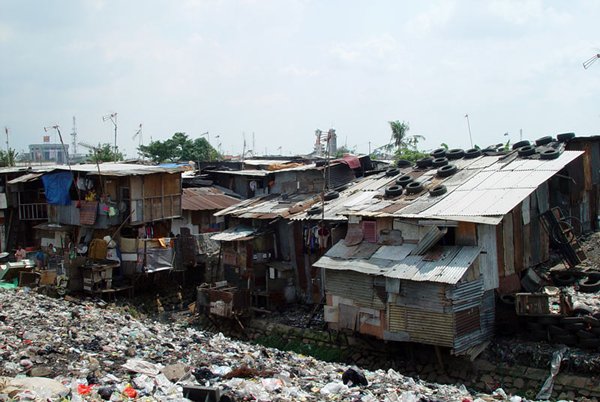
Jakarta slums: Set to be cleared in a massive China-backed development programme.
It wasn't by chance that Xi Jinping, the Chinese President, chose Indonesia as the setting for the 2013 launch of the Belt and Road Initiative (BRI). As the largest economy in the ASEAN bloc and with the highest population, Indonesia is rich in the natural resources that China lacks. Despite this, its growth has long been hamstrung by poor infrastructure and limited investment. By contrast, China is short on natural resources, flush with money to invest and eager for new markets to replace the still flagging demand in the US and Europe. For many, then, there is a natural fit between the two economies.
Subsequently, Indonesia has proved to be a key link in the proposed Maritime Silk Road, the element of the BRI that focuses on the development of sea ports, aviation resources, energy and communications. An archipelago nation, Indonesia has been noticeably short of investment in all of these sectors.
According to figures from the country's Ministry of National Development Planning (Bappenas), Indonesia needs IDR7,200 trillion (US$600 billion) to support its planned infrastructure upgrades over the 2015-2020 period. With the central government only able to supply about 25% of the required funding, overseas investment is seen as essential. It is hardly surprising, then, that Indonesia has been a prime supporter of the China-driven Asian Investment Infrastructure Bank (AIIB). At present, it is the AIIB's eighth-largest shareholder, with a capital subscription of $3.36 billion.
Although Indonesia had already found some success in boosting its inward investment, since the launch of the BRI programme its progress has accelerated substantially. According to the Indonesian Investment Coordination Board, the country attracted inward investment of $628 million in 2015. For 2016, the total for the first quarter alone stood at $500 million.
There has also been a fundamental change in the source of its investment. Most notably, US FDI in Indonesia has declined dramatically, falling from 8.3% in 2013 to 2% in 2015. This shortfall, however, has been more than made up for by investment from Singapore, Japan, China and Hong Kong.
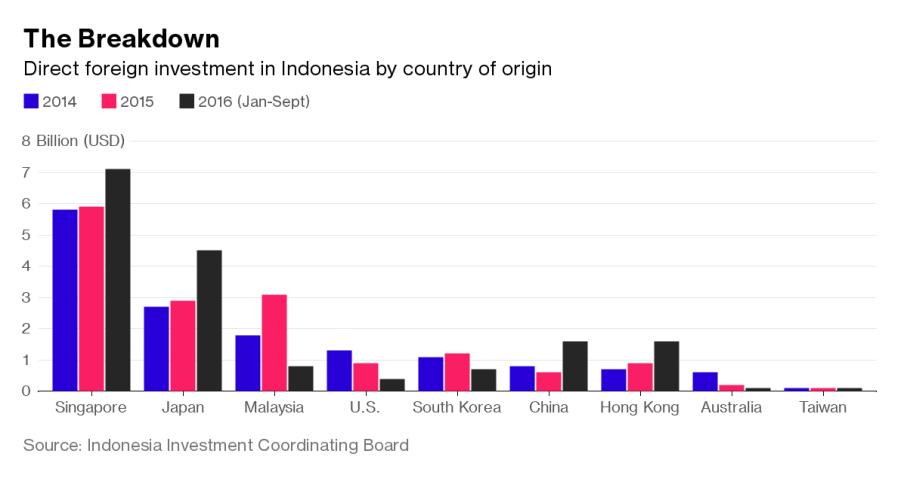
China, of course, has significantly ramped up its investment. In 2015, a financing framework of $3 billion was agreed upon in a Memorandum of Understanding (MoU) between the Chinese and Indonesian governments. This saw the China Development Bank agree to fund 52 projects in co-operation with a number of local Indonesian financial institutions.
Speaking after the announcement of the MoU, Azhar Lubis, the Deputy Chairman of the Indonesian Investment Coordination Board's Department of Investment Supervision, said: "Over the coming years, the level of potential investment from China will remain high. Our biggest challenge is ensuring that potential can be realised quickly."
To date, one of the major projects to have received Chinese funding is the Tanjung Sauh Port on Batam Island, an Indonesian Free Trade Zone just to the south of Singapore. Backed by investment from the China CAMC Engineering Company, it is hoped that the first phase of the redevelopment of this container-focussed facility will raise its capacity to four million TEUs.
The AIIB has also approved $216.5 million of funding for Indonesia's National Slum Upgrading Project. The initiative has been co-financed with the World Bank and is intended to improve access to urban infrastructure and services for the 9.7 million of the poorest residents of 154 towns and cities across Indonesia.
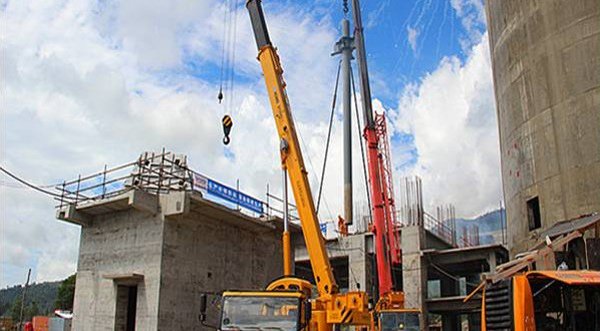
Concrete investment: The Papua Cement Plant.
In terms of rail infrastructure, the Jakarta-Bandung High Speed Link is now being developed by PT Kereta Cepat Indonesia China. The company is a joint venture between a consortium of Indonesian state-owned businesses and China Railway International, with the project being backed by the China Development Bank.
On the utility front, PLN – a state-owned Indonesian electricity provider – has signed up to deliver 17,331 megawatts, with Chinese companies set to utilise 46% of this capacity. China has also funded the construction of the Medan-Kuala Namu-Tebing Tinggi Toll Road in Sumatra, the Cisumdawu Toll Road in Java, the Manado-Bitung Toll Road in North Sulawesi and the Samarinda-Balikpapan Toll Road in Kalimantan. Mainland money also contributed to the costs of constructing the Manokwari Cement Production Plant in Papua.
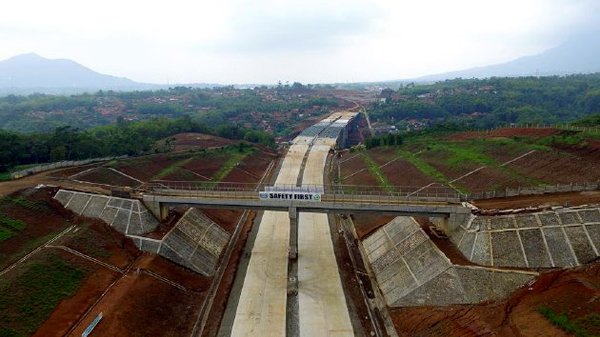
Backed by mainland money: The Cisumdawu Toll Road in Java.
Hong Kong, too, has been keen to accelerate its own investment programme, signing an MoU with representatives of Indonesia in May 2016. Highlighting the role Hong Kong is playing in the development of the BRI, Charles Ng, InvestHK's Acting Director General of Investment, said: "The MoU signed with Indonesia is the ninth that we have signed with a country along the BRI route. As a 'super-connector' between mainland China and the ASEAN bloc, Hong Kong provides an excellent platform for any Indonesian company looking to access the vast mainland market, as well as for any mainland business looking to explore the ASEAN market."
Geoff de Freitas, Special Correspondent, Jakarta
Editor's picks
Trending articles
With an open and transparent market and a level playing field, Hong Kong attracts an international group of world-class professionals who are looking to take the lead in Asia. Such expertise will be critical for businesses aiming to find opportunities under mainland China’s new development strategy known as the Belt and Road Initiative.
Editor's picks
Trending articles
10 Jan 2017
“One Belt, One Road” - Mapping China’s main outbound route
By Pinsent Masons
Pinsent Masons has supported The Economist Corporate Network to create,'One Belt, One Road: an economic roadmap', a series of guides to areas including Africa, Asia, the Middle East and Eastern Europe.
The publication provides informed consideration about the opportunities and implications of OBOR. Along with mapping investment routes and opportunities, the reports feature insight on:
- Infrastructure projects and plans
- The likely impact of local political conditions on investment
- Key economic indicators
- A transparency and stability index.
The regional sections list infrastructure project pipelines with analysis of the infrastructure need in the constituent countries. The analysis examines the progress of prominent OBOR projects and conclude with a series country profiles that offer brief but detailed political-economic portraits.
The country profiles include an “infrastructure risk radar” that succinctly relates the state of core elements in a nation’s infrastructure base: port facilities, air transport facilities, retail and distribution network, telephone network, road network, power network, rail network and IT infrastructure.
The profiles list population and key economic indicators and contain a table on operating risk measures. The operating risk measures look at risk levels for security, political stability, government effectiveness, legal and regulatory conditions, the macroeconomy, foreign trade and payment, finance, tax policy, the labour market and infrastructure.
The Economist Intelligence Unit Democracy Index 2015 and its previous annual editions provide further context for describing a country’s system of government, governance quality and environment for transparency.
Please click to view the profiles of over 44 countries, ranging from Albania to Zimbabwe.
Editor's picks
Trending articles
HKTDC Research | 12 Jan 2017
Guangdong Enterprises Tapping Belt and Road Opportunities: Kennede Electronics Steps Up Exports
Kennede Electronics Co Ltd is one of the many businesses looking to capitalise on China’s Belt and Road Initiative as a way of tapping the rapidly growing Asian markets. The company has hopes of exploring investment opportunities in a number of areas, including Africa, in a bid to reduce its production costs, while strengthening its market coverage in Asia and Europe. Additionally, in order to advance its production and global sales, Kennede Electronics is in the process to set up a company based in Hong Kong to take advantage of the city’s professional services and trade facilities.
Belt and Road Markets Look Promising

Headquartered in Guangdong’s Jiangmen city, Kennede Electronics is a specialist maker of backup lighting and electrical products. At present, the company is optimistic about the market potential of the Asian countries along the Belt and Road. It has plans to further develop its dealings with the major South Asian markets, notably India and Pakistan, as well as the Southeast Asian markets in Malaysia and Thailand.
A representative of the company told HKTDC Research that demand within the global lighting market is mostly stable at present. However, growth in the developed markets, such as Europe and the United States is relatively slow. Somewhat against the odds, then, over recent years the company has achieved impressive sales figures by developing new products, building new sales channels and opening new markets.
Since its inception in 2000, Kennede Electronics has focussed on production and overseas trade for its main exports. These exports cover major lighting series - rechargeable indoor and outdoor backup lighting; rechargeable flashlights; and fire emergency lights. They also include rechargeable desktop and floor fans. Kennede currently owns more than 600 series of products, marketing them to more than 100 countries and regions. In January 2014, the company was listed on the Small and Medium-sized Enterprise Board in the Shenzhen Stock Exchange.
Exploring Overseas Investment Opportunities
Kennede Electronics has comprehensive plans in place to expand its production capacity to match future business developments. These plans cover the increased application of standard modules, as well as altering product design to better suit its Jiangmen plant’s automated production capacity.

The company also intends to explore investment in manufacturing plants within the central region of China. It is also studying the feasibility of setting up production lines in Africa. It plans to combine foreign labour and production resources in order to better control its overall production costs, and break into the African markets via local strongholds. In all, using Africa as an overseas production base could enable the company to service the European market more effectively.
When evaluating potential investment in production projects, the company believes that a number of major factors - other than labour supply and production costs - must be considered. The environmental protection requirements of investment locations, as well as other matters such as supply chain and production materials support, also need to be taken into account. Consequently, the company is looking to build its local knowledge prior to any potential investment in Africa.
Although Southeast Asia is geographically closer to China, the company reckons that the continuous inflow of foreign capital has prompted a surge in local production costs. As the labour supply is no longer abundant, some Southeast Asian countries have begun to tighten their requirements for foreign investment in production projects. As a result of this, the company is currently focused on African investment projects, and has reduced its focus on investment opportunities within Southeast Asia.
At present Kennede Electronics is in the process of setting up a company in Hong Kong. As an international financial centre, Hong Kong offers facilities for dealing with foreign exchange, collecting international payments and securing cost-effective capital to finance growing international business. The company also hopes to take advantage of Hong Kong's professional consulting services, amongst others, to undertake feasibility studies in overseas investment projects and early due diligence. This would enable it to control its investment risks and carry out appropriate tax planning to avoid the unnecessary burden of double taxation.
HKTDC Research would like to acknowledge the help extended by the Department of Commerce of Guangdong Province and the Bureau of Commerce of Jiangmen City in conducting surveys and company visits.
| Content provided by |  |
















